Nursing Analysis: Critical Analysis of Mrs. Grace's Case Study
VerifiedAdded on 2022/08/12
|11
|2637
|17
Case Study
AI Summary
This case study presents a nursing analysis of Mrs. Grace, an 80-year-old woman admitted to the Emergency Department after a fall, resulting in a fractured neck of the femur. The analysis details her initial assessment, including vital signs, GCS score, and medical history, highlighting the importance of monitoring her cognition, temperature, heart rate, and pain levels. The study emphasizes the need for a thorough pain assessment using a pain scale and a review of her medical and social history to understand the cause of the fall. Mrs. Grace's medical history includes atrial fibrillation, hypertension, and ischemic heart disease, influencing the nursing interventions, which include dietary changes and managing immobility to prevent pressure ulcers. The analysis reviews her medication regimen, including Bupivacaine + fentanyl femoral block, Panadol, Morphine, and Neurofen, underscoring the importance of safe medication management considering her age and potential side effects. The long-term effects of her medications are also discussed, emphasizing the need for patient education and communication with family members to enhance her overall well-being. The conclusion highlights the crucial role of nurses in managing Mrs. Grace's condition, focusing on pain reduction, preventing pressure ulcers, and considering her age and medication side effects.

Running head: NURSING ANALYSIS
Nursing Analysis
Name of the Student
Name of the University
Author Note
Nursing Analysis
Name of the Student
Name of the University
Author Note
Paraphrase This Document
Need a fresh take? Get an instant paraphrase of this document with our AI Paraphraser
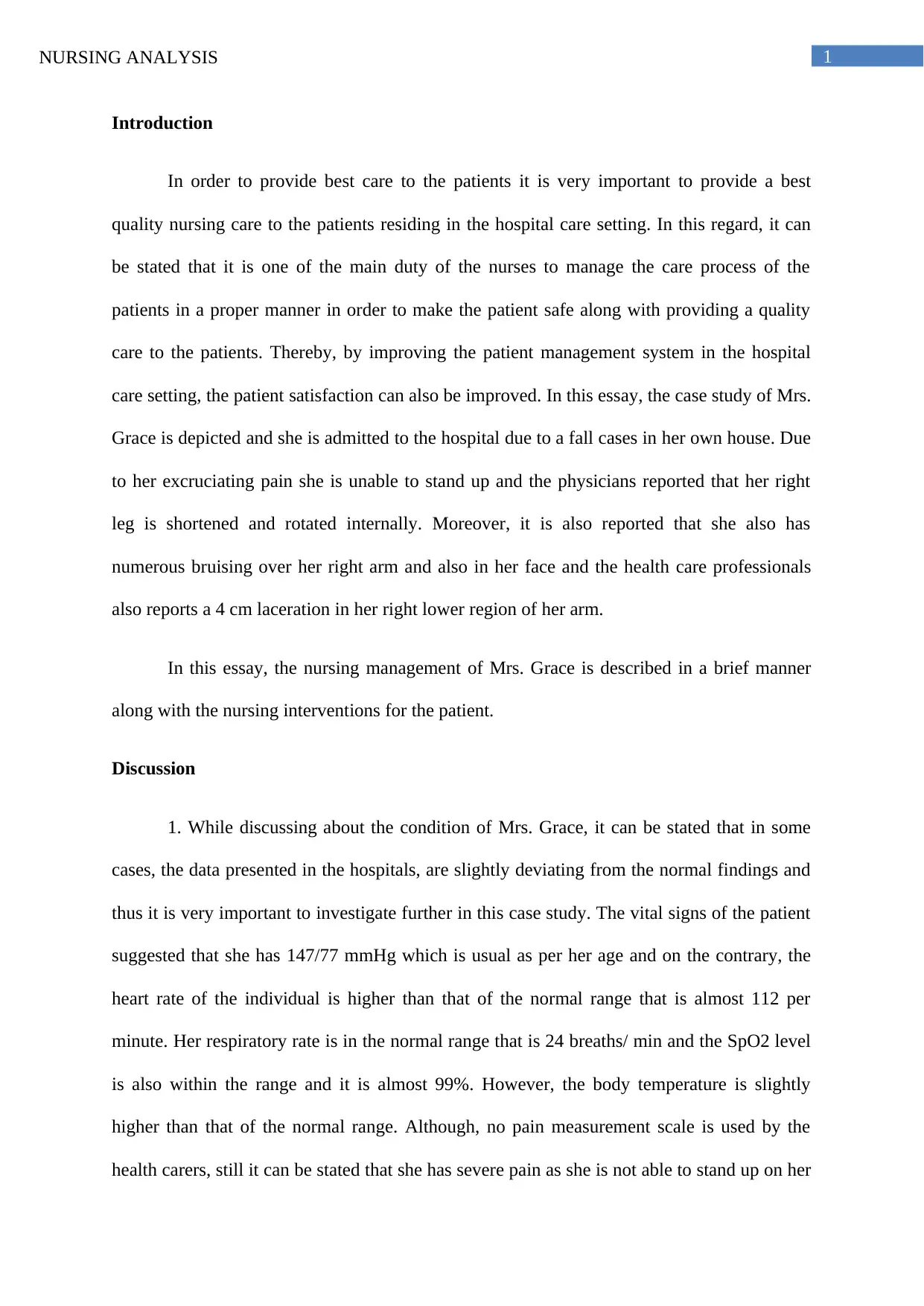
1NURSING ANALYSIS
Introduction
In order to provide best care to the patients it is very important to provide a best
quality nursing care to the patients residing in the hospital care setting. In this regard, it can
be stated that it is one of the main duty of the nurses to manage the care process of the
patients in a proper manner in order to make the patient safe along with providing a quality
care to the patients. Thereby, by improving the patient management system in the hospital
care setting, the patient satisfaction can also be improved. In this essay, the case study of Mrs.
Grace is depicted and she is admitted to the hospital due to a fall cases in her own house. Due
to her excruciating pain she is unable to stand up and the physicians reported that her right
leg is shortened and rotated internally. Moreover, it is also reported that she also has
numerous bruising over her right arm and also in her face and the health care professionals
also reports a 4 cm laceration in her right lower region of her arm.
In this essay, the nursing management of Mrs. Grace is described in a brief manner
along with the nursing interventions for the patient.
Discussion
1. While discussing about the condition of Mrs. Grace, it can be stated that in some
cases, the data presented in the hospitals, are slightly deviating from the normal findings and
thus it is very important to investigate further in this case study. The vital signs of the patient
suggested that she has 147/77 mmHg which is usual as per her age and on the contrary, the
heart rate of the individual is higher than that of the normal range that is almost 112 per
minute. Her respiratory rate is in the normal range that is 24 breaths/ min and the SpO2 level
is also within the range and it is almost 99%. However, the body temperature is slightly
higher than that of the normal range. Although, no pain measurement scale is used by the
health carers, still it can be stated that she has severe pain as she is not able to stand up on her
Introduction
In order to provide best care to the patients it is very important to provide a best
quality nursing care to the patients residing in the hospital care setting. In this regard, it can
be stated that it is one of the main duty of the nurses to manage the care process of the
patients in a proper manner in order to make the patient safe along with providing a quality
care to the patients. Thereby, by improving the patient management system in the hospital
care setting, the patient satisfaction can also be improved. In this essay, the case study of Mrs.
Grace is depicted and she is admitted to the hospital due to a fall cases in her own house. Due
to her excruciating pain she is unable to stand up and the physicians reported that her right
leg is shortened and rotated internally. Moreover, it is also reported that she also has
numerous bruising over her right arm and also in her face and the health care professionals
also reports a 4 cm laceration in her right lower region of her arm.
In this essay, the nursing management of Mrs. Grace is described in a brief manner
along with the nursing interventions for the patient.
Discussion
1. While discussing about the condition of Mrs. Grace, it can be stated that in some
cases, the data presented in the hospitals, are slightly deviating from the normal findings and
thus it is very important to investigate further in this case study. The vital signs of the patient
suggested that she has 147/77 mmHg which is usual as per her age and on the contrary, the
heart rate of the individual is higher than that of the normal range that is almost 112 per
minute. Her respiratory rate is in the normal range that is 24 breaths/ min and the SpO2 level
is also within the range and it is almost 99%. However, the body temperature is slightly
higher than that of the normal range. Although, no pain measurement scale is used by the
health carers, still it can be stated that she has severe pain as she is not able to stand up on her
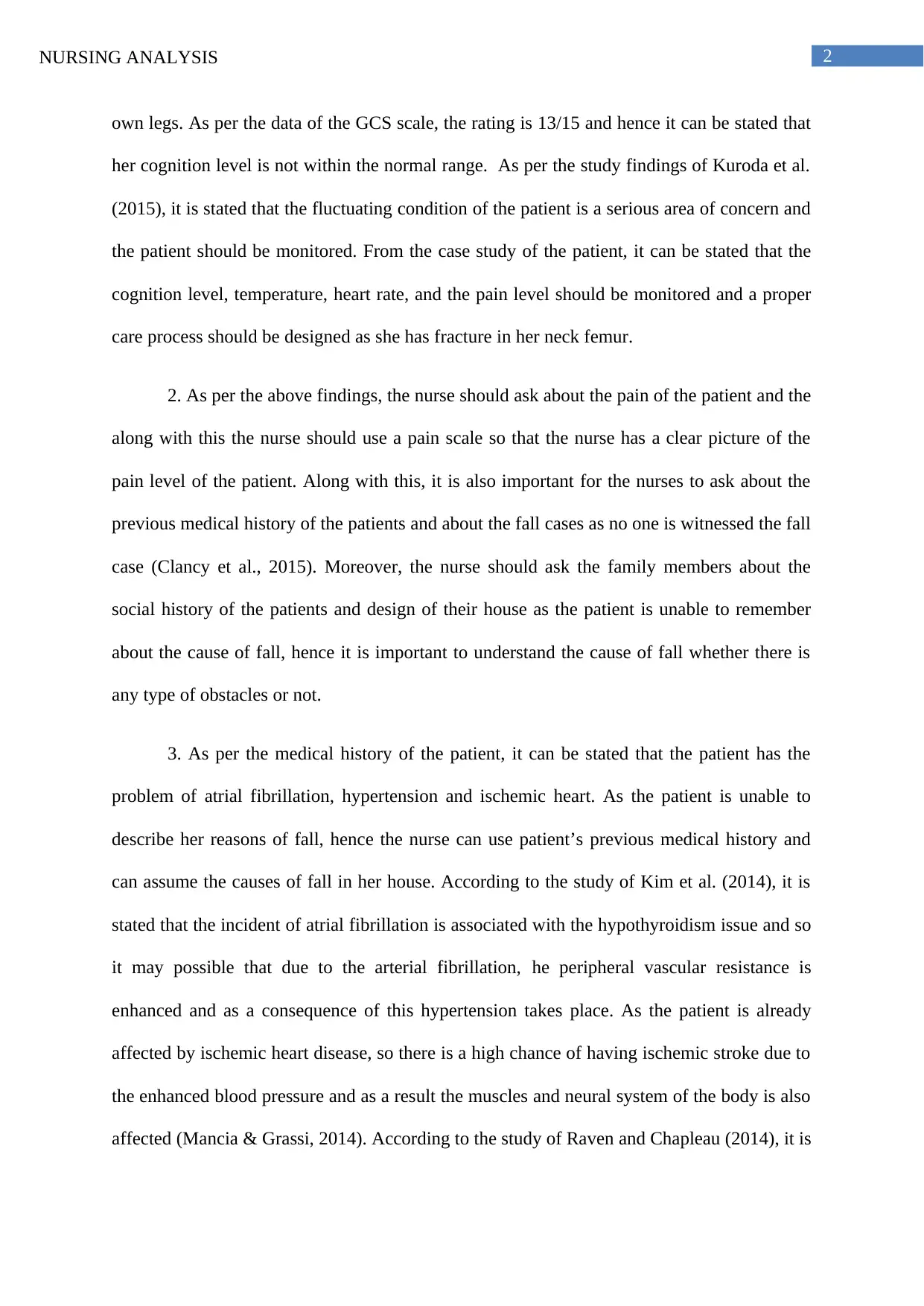
2NURSING ANALYSIS
own legs. As per the data of the GCS scale, the rating is 13/15 and hence it can be stated that
her cognition level is not within the normal range. As per the study findings of Kuroda et al.
(2015), it is stated that the fluctuating condition of the patient is a serious area of concern and
the patient should be monitored. From the case study of the patient, it can be stated that the
cognition level, temperature, heart rate, and the pain level should be monitored and a proper
care process should be designed as she has fracture in her neck femur.
2. As per the above findings, the nurse should ask about the pain of the patient and the
along with this the nurse should use a pain scale so that the nurse has a clear picture of the
pain level of the patient. Along with this, it is also important for the nurses to ask about the
previous medical history of the patients and about the fall cases as no one is witnessed the fall
case (Clancy et al., 2015). Moreover, the nurse should ask the family members about the
social history of the patients and design of their house as the patient is unable to remember
about the cause of fall, hence it is important to understand the cause of fall whether there is
any type of obstacles or not.
3. As per the medical history of the patient, it can be stated that the patient has the
problem of atrial fibrillation, hypertension and ischemic heart. As the patient is unable to
describe her reasons of fall, hence the nurse can use patient’s previous medical history and
can assume the causes of fall in her house. According to the study of Kim et al. (2014), it is
stated that the incident of atrial fibrillation is associated with the hypothyroidism issue and so
it may possible that due to the arterial fibrillation, he peripheral vascular resistance is
enhanced and as a consequence of this hypertension takes place. As the patient is already
affected by ischemic heart disease, so there is a high chance of having ischemic stroke due to
the enhanced blood pressure and as a result the muscles and neural system of the body is also
affected (Mancia & Grassi, 2014). According to the study of Raven and Chapleau (2014), it is
own legs. As per the data of the GCS scale, the rating is 13/15 and hence it can be stated that
her cognition level is not within the normal range. As per the study findings of Kuroda et al.
(2015), it is stated that the fluctuating condition of the patient is a serious area of concern and
the patient should be monitored. From the case study of the patient, it can be stated that the
cognition level, temperature, heart rate, and the pain level should be monitored and a proper
care process should be designed as she has fracture in her neck femur.
2. As per the above findings, the nurse should ask about the pain of the patient and the
along with this the nurse should use a pain scale so that the nurse has a clear picture of the
pain level of the patient. Along with this, it is also important for the nurses to ask about the
previous medical history of the patients and about the fall cases as no one is witnessed the fall
case (Clancy et al., 2015). Moreover, the nurse should ask the family members about the
social history of the patients and design of their house as the patient is unable to remember
about the cause of fall, hence it is important to understand the cause of fall whether there is
any type of obstacles or not.
3. As per the medical history of the patient, it can be stated that the patient has the
problem of atrial fibrillation, hypertension and ischemic heart. As the patient is unable to
describe her reasons of fall, hence the nurse can use patient’s previous medical history and
can assume the causes of fall in her house. According to the study of Kim et al. (2014), it is
stated that the incident of atrial fibrillation is associated with the hypothyroidism issue and so
it may possible that due to the arterial fibrillation, he peripheral vascular resistance is
enhanced and as a consequence of this hypertension takes place. As the patient is already
affected by ischemic heart disease, so there is a high chance of having ischemic stroke due to
the enhanced blood pressure and as a result the muscles and neural system of the body is also
affected (Mancia & Grassi, 2014). According to the study of Raven and Chapleau (2014), it is
⊘ This is a preview!⊘
Do you want full access?
Subscribe today to unlock all pages.

Trusted by 1+ million students worldwide
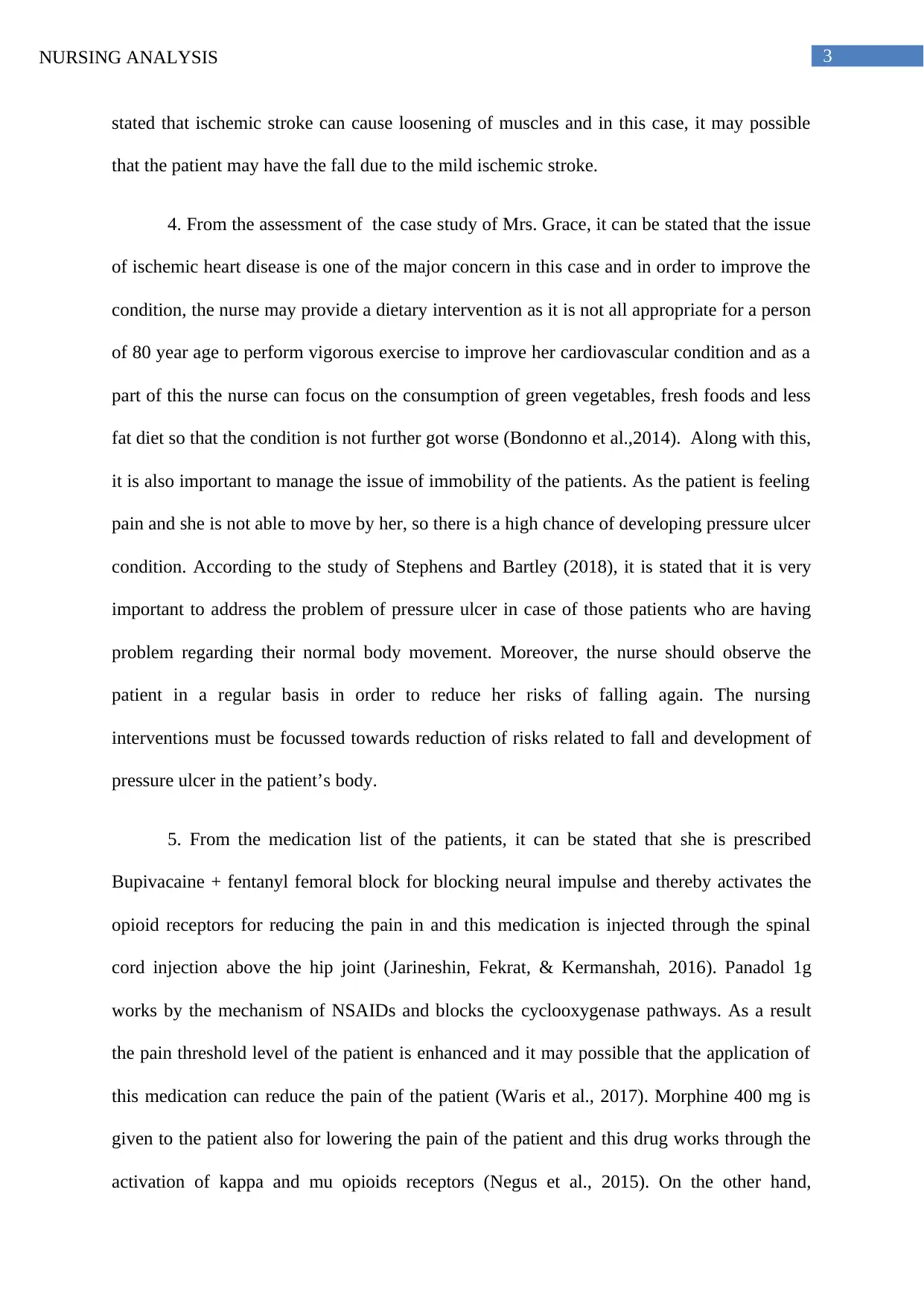
3NURSING ANALYSIS
stated that ischemic stroke can cause loosening of muscles and in this case, it may possible
that the patient may have the fall due to the mild ischemic stroke.
4. From the assessment of the case study of Mrs. Grace, it can be stated that the issue
of ischemic heart disease is one of the major concern in this case and in order to improve the
condition, the nurse may provide a dietary intervention as it is not all appropriate for a person
of 80 year age to perform vigorous exercise to improve her cardiovascular condition and as a
part of this the nurse can focus on the consumption of green vegetables, fresh foods and less
fat diet so that the condition is not further got worse (Bondonno et al.,2014). Along with this,
it is also important to manage the issue of immobility of the patients. As the patient is feeling
pain and she is not able to move by her, so there is a high chance of developing pressure ulcer
condition. According to the study of Stephens and Bartley (2018), it is stated that it is very
important to address the problem of pressure ulcer in case of those patients who are having
problem regarding their normal body movement. Moreover, the nurse should observe the
patient in a regular basis in order to reduce her risks of falling again. The nursing
interventions must be focussed towards reduction of risks related to fall and development of
pressure ulcer in the patient’s body.
5. From the medication list of the patients, it can be stated that she is prescribed
Bupivacaine + fentanyl femoral block for blocking neural impulse and thereby activates the
opioid receptors for reducing the pain in and this medication is injected through the spinal
cord injection above the hip joint (Jarineshin, Fekrat, & Kermanshah, 2016). Panadol 1g
works by the mechanism of NSAIDs and blocks the cyclooxygenase pathways. As a result
the pain threshold level of the patient is enhanced and it may possible that the application of
this medication can reduce the pain of the patient (Waris et al., 2017). Morphine 400 mg is
given to the patient also for lowering the pain of the patient and this drug works through the
activation of kappa and mu opioids receptors (Negus et al., 2015). On the other hand,
stated that ischemic stroke can cause loosening of muscles and in this case, it may possible
that the patient may have the fall due to the mild ischemic stroke.
4. From the assessment of the case study of Mrs. Grace, it can be stated that the issue
of ischemic heart disease is one of the major concern in this case and in order to improve the
condition, the nurse may provide a dietary intervention as it is not all appropriate for a person
of 80 year age to perform vigorous exercise to improve her cardiovascular condition and as a
part of this the nurse can focus on the consumption of green vegetables, fresh foods and less
fat diet so that the condition is not further got worse (Bondonno et al.,2014). Along with this,
it is also important to manage the issue of immobility of the patients. As the patient is feeling
pain and she is not able to move by her, so there is a high chance of developing pressure ulcer
condition. According to the study of Stephens and Bartley (2018), it is stated that it is very
important to address the problem of pressure ulcer in case of those patients who are having
problem regarding their normal body movement. Moreover, the nurse should observe the
patient in a regular basis in order to reduce her risks of falling again. The nursing
interventions must be focussed towards reduction of risks related to fall and development of
pressure ulcer in the patient’s body.
5. From the medication list of the patients, it can be stated that she is prescribed
Bupivacaine + fentanyl femoral block for blocking neural impulse and thereby activates the
opioid receptors for reducing the pain in and this medication is injected through the spinal
cord injection above the hip joint (Jarineshin, Fekrat, & Kermanshah, 2016). Panadol 1g
works by the mechanism of NSAIDs and blocks the cyclooxygenase pathways. As a result
the pain threshold level of the patient is enhanced and it may possible that the application of
this medication can reduce the pain of the patient (Waris et al., 2017). Morphine 400 mg is
given to the patient also for lowering the pain of the patient and this drug works through the
activation of kappa and mu opioids receptors (Negus et al., 2015). On the other hand,
Paraphrase This Document
Need a fresh take? Get an instant paraphrase of this document with our AI Paraphraser
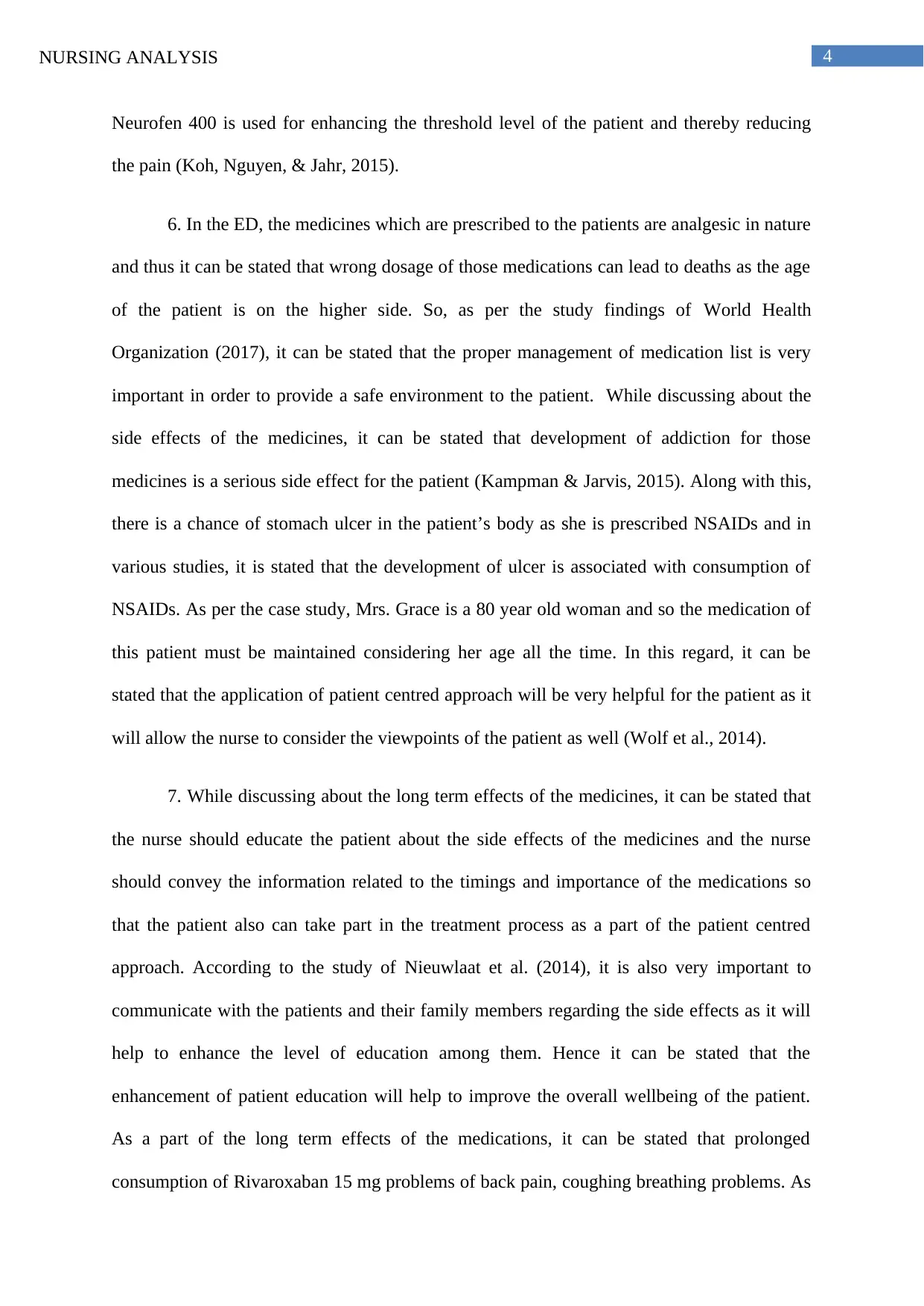
4NURSING ANALYSIS
Neurofen 400 is used for enhancing the threshold level of the patient and thereby reducing
the pain (Koh, Nguyen, & Jahr, 2015).
6. In the ED, the medicines which are prescribed to the patients are analgesic in nature
and thus it can be stated that wrong dosage of those medications can lead to deaths as the age
of the patient is on the higher side. So, as per the study findings of World Health
Organization (2017), it can be stated that the proper management of medication list is very
important in order to provide a safe environment to the patient. While discussing about the
side effects of the medicines, it can be stated that development of addiction for those
medicines is a serious side effect for the patient (Kampman & Jarvis, 2015). Along with this,
there is a chance of stomach ulcer in the patient’s body as she is prescribed NSAIDs and in
various studies, it is stated that the development of ulcer is associated with consumption of
NSAIDs. As per the case study, Mrs. Grace is a 80 year old woman and so the medication of
this patient must be maintained considering her age all the time. In this regard, it can be
stated that the application of patient centred approach will be very helpful for the patient as it
will allow the nurse to consider the viewpoints of the patient as well (Wolf et al., 2014).
7. While discussing about the long term effects of the medicines, it can be stated that
the nurse should educate the patient about the side effects of the medicines and the nurse
should convey the information related to the timings and importance of the medications so
that the patient also can take part in the treatment process as a part of the patient centred
approach. According to the study of Nieuwlaat et al. (2014), it is also very important to
communicate with the patients and their family members regarding the side effects as it will
help to enhance the level of education among them. Hence it can be stated that the
enhancement of patient education will help to improve the overall wellbeing of the patient.
As a part of the long term effects of the medications, it can be stated that prolonged
consumption of Rivaroxaban 15 mg problems of back pain, coughing breathing problems. As
Neurofen 400 is used for enhancing the threshold level of the patient and thereby reducing
the pain (Koh, Nguyen, & Jahr, 2015).
6. In the ED, the medicines which are prescribed to the patients are analgesic in nature
and thus it can be stated that wrong dosage of those medications can lead to deaths as the age
of the patient is on the higher side. So, as per the study findings of World Health
Organization (2017), it can be stated that the proper management of medication list is very
important in order to provide a safe environment to the patient. While discussing about the
side effects of the medicines, it can be stated that development of addiction for those
medicines is a serious side effect for the patient (Kampman & Jarvis, 2015). Along with this,
there is a chance of stomach ulcer in the patient’s body as she is prescribed NSAIDs and in
various studies, it is stated that the development of ulcer is associated with consumption of
NSAIDs. As per the case study, Mrs. Grace is a 80 year old woman and so the medication of
this patient must be maintained considering her age all the time. In this regard, it can be
stated that the application of patient centred approach will be very helpful for the patient as it
will allow the nurse to consider the viewpoints of the patient as well (Wolf et al., 2014).
7. While discussing about the long term effects of the medicines, it can be stated that
the nurse should educate the patient about the side effects of the medicines and the nurse
should convey the information related to the timings and importance of the medications so
that the patient also can take part in the treatment process as a part of the patient centred
approach. According to the study of Nieuwlaat et al. (2014), it is also very important to
communicate with the patients and their family members regarding the side effects as it will
help to enhance the level of education among them. Hence it can be stated that the
enhancement of patient education will help to improve the overall wellbeing of the patient.
As a part of the long term effects of the medications, it can be stated that prolonged
consumption of Rivaroxaban 15 mg problems of back pain, coughing breathing problems. As
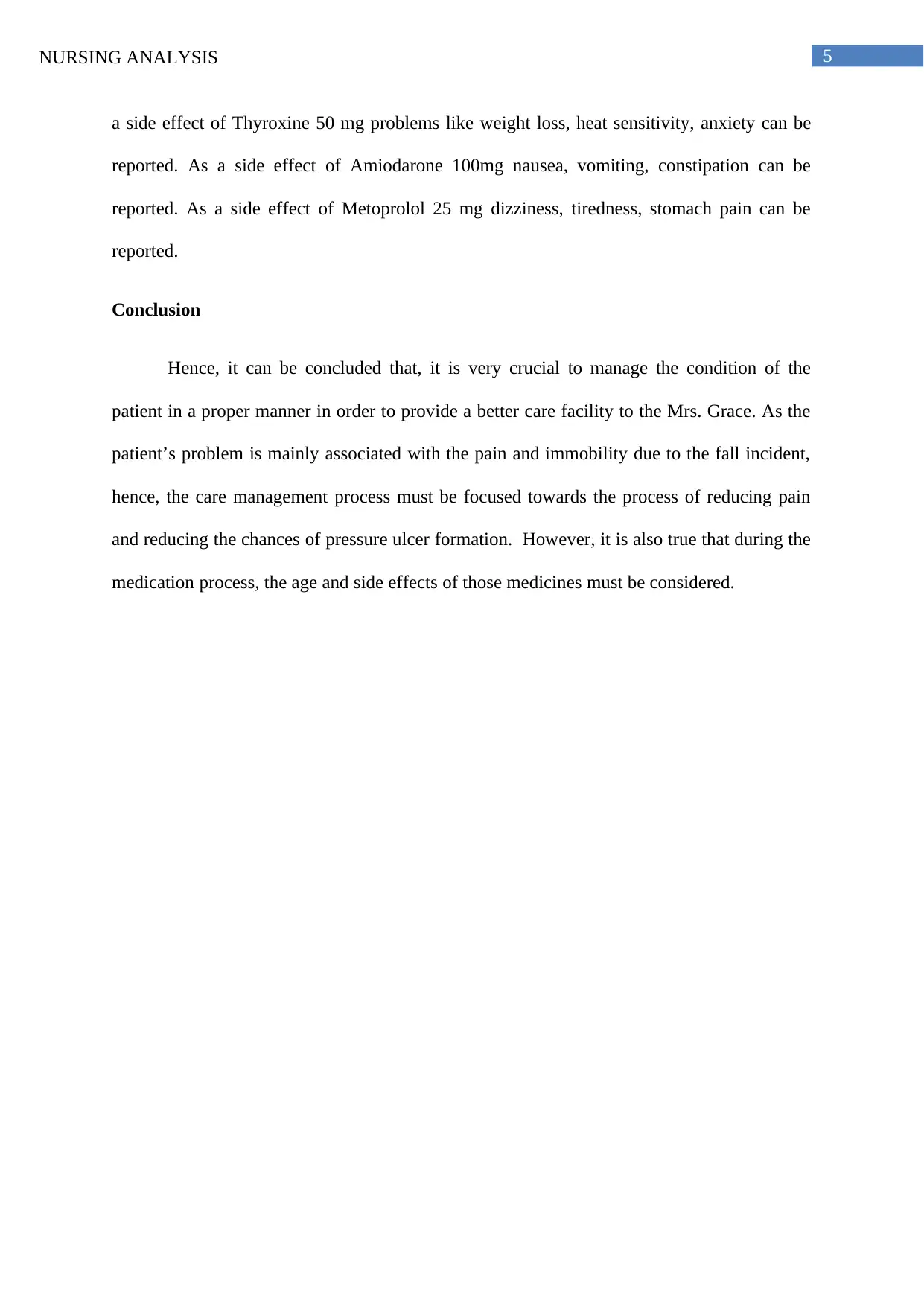
5NURSING ANALYSIS
a side effect of Thyroxine 50 mg problems like weight loss, heat sensitivity, anxiety can be
reported. As a side effect of Amiodarone 100mg nausea, vomiting, constipation can be
reported. As a side effect of Metoprolol 25 mg dizziness, tiredness, stomach pain can be
reported.
Conclusion
Hence, it can be concluded that, it is very crucial to manage the condition of the
patient in a proper manner in order to provide a better care facility to the Mrs. Grace. As the
patient’s problem is mainly associated with the pain and immobility due to the fall incident,
hence, the care management process must be focused towards the process of reducing pain
and reducing the chances of pressure ulcer formation. However, it is also true that during the
medication process, the age and side effects of those medicines must be considered.
a side effect of Thyroxine 50 mg problems like weight loss, heat sensitivity, anxiety can be
reported. As a side effect of Amiodarone 100mg nausea, vomiting, constipation can be
reported. As a side effect of Metoprolol 25 mg dizziness, tiredness, stomach pain can be
reported.
Conclusion
Hence, it can be concluded that, it is very crucial to manage the condition of the
patient in a proper manner in order to provide a better care facility to the Mrs. Grace. As the
patient’s problem is mainly associated with the pain and immobility due to the fall incident,
hence, the care management process must be focused towards the process of reducing pain
and reducing the chances of pressure ulcer formation. However, it is also true that during the
medication process, the age and side effects of those medicines must be considered.
⊘ This is a preview!⊘
Do you want full access?
Subscribe today to unlock all pages.

Trusted by 1+ million students worldwide
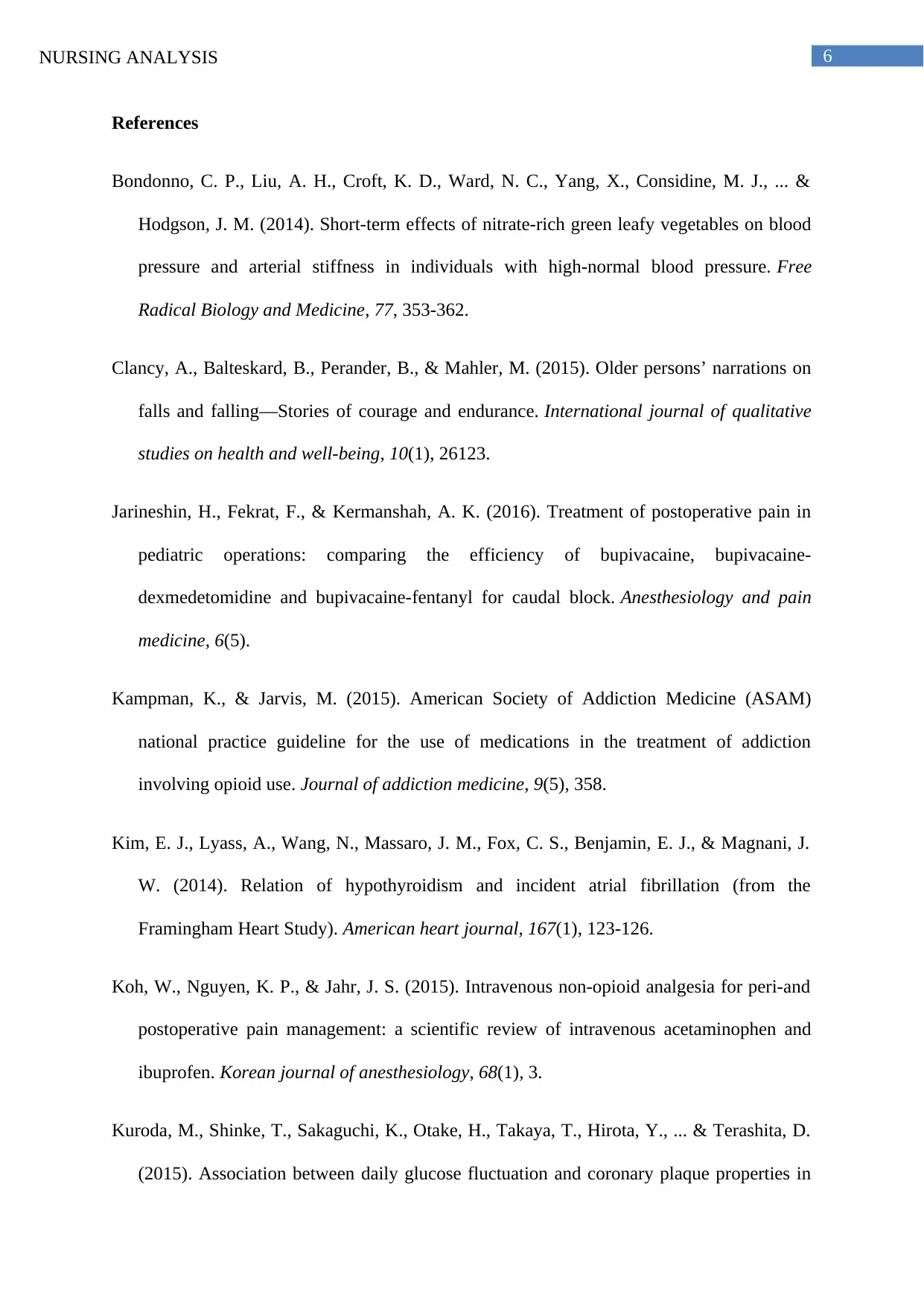
6NURSING ANALYSIS
References
Bondonno, C. P., Liu, A. H., Croft, K. D., Ward, N. C., Yang, X., Considine, M. J., ... &
Hodgson, J. M. (2014). Short-term effects of nitrate-rich green leafy vegetables on blood
pressure and arterial stiffness in individuals with high-normal blood pressure. Free
Radical Biology and Medicine, 77, 353-362.
Clancy, A., Balteskard, B., Perander, B., & Mahler, M. (2015). Older persons’ narrations on
falls and falling—Stories of courage and endurance. International journal of qualitative
studies on health and well-being, 10(1), 26123.
Jarineshin, H., Fekrat, F., & Kermanshah, A. K. (2016). Treatment of postoperative pain in
pediatric operations: comparing the efficiency of bupivacaine, bupivacaine-
dexmedetomidine and bupivacaine-fentanyl for caudal block. Anesthesiology and pain
medicine, 6(5).
Kampman, K., & Jarvis, M. (2015). American Society of Addiction Medicine (ASAM)
national practice guideline for the use of medications in the treatment of addiction
involving opioid use. Journal of addiction medicine, 9(5), 358.
Kim, E. J., Lyass, A., Wang, N., Massaro, J. M., Fox, C. S., Benjamin, E. J., & Magnani, J.
W. (2014). Relation of hypothyroidism and incident atrial fibrillation (from the
Framingham Heart Study). American heart journal, 167(1), 123-126.
Koh, W., Nguyen, K. P., & Jahr, J. S. (2015). Intravenous non-opioid analgesia for peri-and
postoperative pain management: a scientific review of intravenous acetaminophen and
ibuprofen. Korean journal of anesthesiology, 68(1), 3.
Kuroda, M., Shinke, T., Sakaguchi, K., Otake, H., Takaya, T., Hirota, Y., ... & Terashita, D.
(2015). Association between daily glucose fluctuation and coronary plaque properties in
References
Bondonno, C. P., Liu, A. H., Croft, K. D., Ward, N. C., Yang, X., Considine, M. J., ... &
Hodgson, J. M. (2014). Short-term effects of nitrate-rich green leafy vegetables on blood
pressure and arterial stiffness in individuals with high-normal blood pressure. Free
Radical Biology and Medicine, 77, 353-362.
Clancy, A., Balteskard, B., Perander, B., & Mahler, M. (2015). Older persons’ narrations on
falls and falling—Stories of courage and endurance. International journal of qualitative
studies on health and well-being, 10(1), 26123.
Jarineshin, H., Fekrat, F., & Kermanshah, A. K. (2016). Treatment of postoperative pain in
pediatric operations: comparing the efficiency of bupivacaine, bupivacaine-
dexmedetomidine and bupivacaine-fentanyl for caudal block. Anesthesiology and pain
medicine, 6(5).
Kampman, K., & Jarvis, M. (2015). American Society of Addiction Medicine (ASAM)
national practice guideline for the use of medications in the treatment of addiction
involving opioid use. Journal of addiction medicine, 9(5), 358.
Kim, E. J., Lyass, A., Wang, N., Massaro, J. M., Fox, C. S., Benjamin, E. J., & Magnani, J.
W. (2014). Relation of hypothyroidism and incident atrial fibrillation (from the
Framingham Heart Study). American heart journal, 167(1), 123-126.
Koh, W., Nguyen, K. P., & Jahr, J. S. (2015). Intravenous non-opioid analgesia for peri-and
postoperative pain management: a scientific review of intravenous acetaminophen and
ibuprofen. Korean journal of anesthesiology, 68(1), 3.
Kuroda, M., Shinke, T., Sakaguchi, K., Otake, H., Takaya, T., Hirota, Y., ... & Terashita, D.
(2015). Association between daily glucose fluctuation and coronary plaque properties in
Paraphrase This Document
Need a fresh take? Get an instant paraphrase of this document with our AI Paraphraser
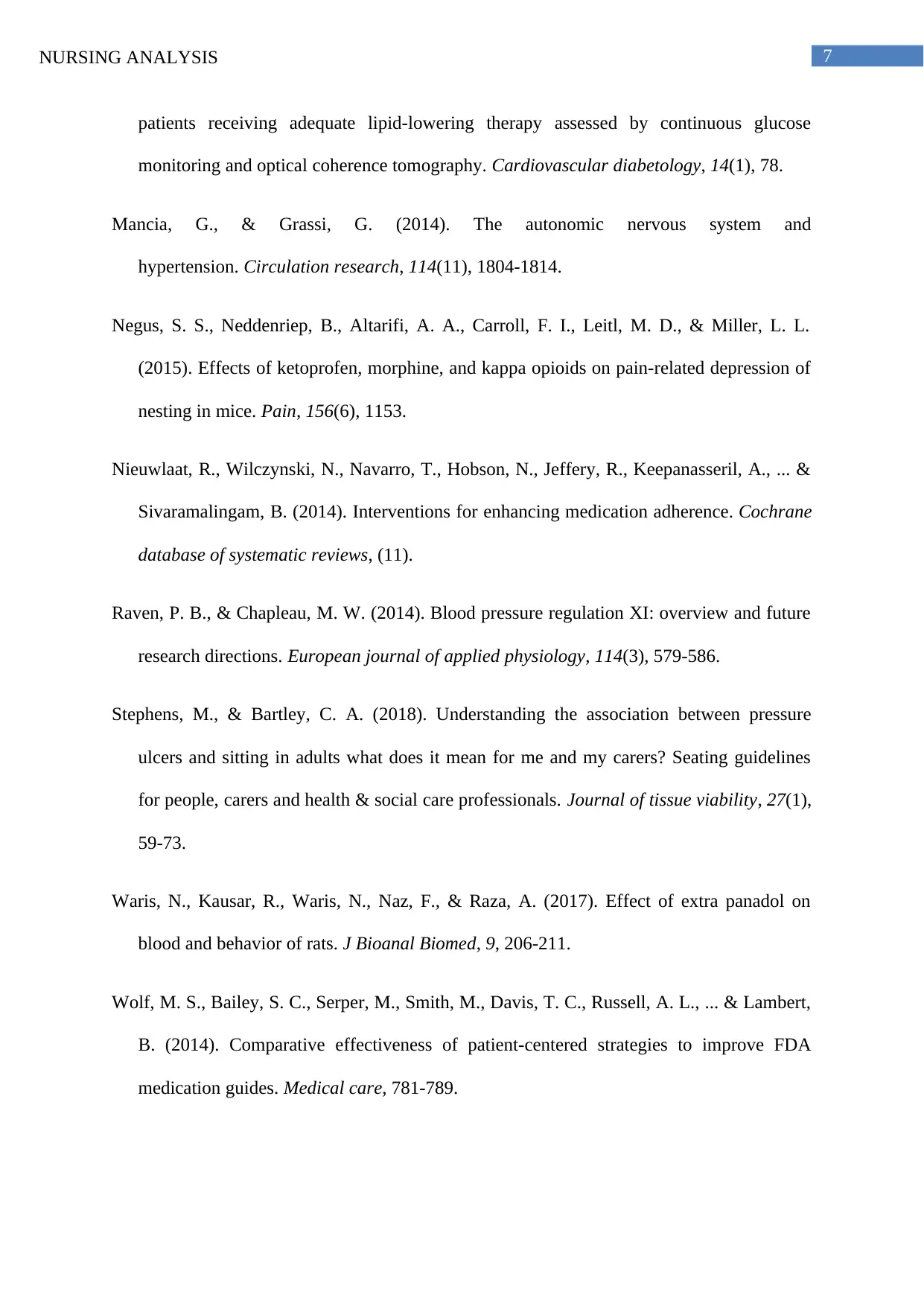
7NURSING ANALYSIS
patients receiving adequate lipid-lowering therapy assessed by continuous glucose
monitoring and optical coherence tomography. Cardiovascular diabetology, 14(1), 78.
Mancia, G., & Grassi, G. (2014). The autonomic nervous system and
hypertension. Circulation research, 114(11), 1804-1814.
Negus, S. S., Neddenriep, B., Altarifi, A. A., Carroll, F. I., Leitl, M. D., & Miller, L. L.
(2015). Effects of ketoprofen, morphine, and kappa opioids on pain-related depression of
nesting in mice. Pain, 156(6), 1153.
Nieuwlaat, R., Wilczynski, N., Navarro, T., Hobson, N., Jeffery, R., Keepanasseril, A., ... &
Sivaramalingam, B. (2014). Interventions for enhancing medication adherence. Cochrane
database of systematic reviews, (11).
Raven, P. B., & Chapleau, M. W. (2014). Blood pressure regulation XI: overview and future
research directions. European journal of applied physiology, 114(3), 579-586.
Stephens, M., & Bartley, C. A. (2018). Understanding the association between pressure
ulcers and sitting in adults what does it mean for me and my carers? Seating guidelines
for people, carers and health & social care professionals. Journal of tissue viability, 27(1),
59-73.
Waris, N., Kausar, R., Waris, N., Naz, F., & Raza, A. (2017). Effect of extra panadol on
blood and behavior of rats. J Bioanal Biomed, 9, 206-211.
Wolf, M. S., Bailey, S. C., Serper, M., Smith, M., Davis, T. C., Russell, A. L., ... & Lambert,
B. (2014). Comparative effectiveness of patient-centered strategies to improve FDA
medication guides. Medical care, 781-789.
patients receiving adequate lipid-lowering therapy assessed by continuous glucose
monitoring and optical coherence tomography. Cardiovascular diabetology, 14(1), 78.
Mancia, G., & Grassi, G. (2014). The autonomic nervous system and
hypertension. Circulation research, 114(11), 1804-1814.
Negus, S. S., Neddenriep, B., Altarifi, A. A., Carroll, F. I., Leitl, M. D., & Miller, L. L.
(2015). Effects of ketoprofen, morphine, and kappa opioids on pain-related depression of
nesting in mice. Pain, 156(6), 1153.
Nieuwlaat, R., Wilczynski, N., Navarro, T., Hobson, N., Jeffery, R., Keepanasseril, A., ... &
Sivaramalingam, B. (2014). Interventions for enhancing medication adherence. Cochrane
database of systematic reviews, (11).
Raven, P. B., & Chapleau, M. W. (2014). Blood pressure regulation XI: overview and future
research directions. European journal of applied physiology, 114(3), 579-586.
Stephens, M., & Bartley, C. A. (2018). Understanding the association between pressure
ulcers and sitting in adults what does it mean for me and my carers? Seating guidelines
for people, carers and health & social care professionals. Journal of tissue viability, 27(1),
59-73.
Waris, N., Kausar, R., Waris, N., Naz, F., & Raza, A. (2017). Effect of extra panadol on
blood and behavior of rats. J Bioanal Biomed, 9, 206-211.
Wolf, M. S., Bailey, S. C., Serper, M., Smith, M., Davis, T. C., Russell, A. L., ... & Lambert,
B. (2014). Comparative effectiveness of patient-centered strategies to improve FDA
medication guides. Medical care, 781-789.

8NURSING ANALYSIS
World Health Organization. (2017). Patient safety: making health care safer (No.
WHO/HIS/SDS/2017.11). World Health Organization.
World Health Organization. (2017). Patient safety: making health care safer (No.
WHO/HIS/SDS/2017.11). World Health Organization.
⊘ This is a preview!⊘
Do you want full access?
Subscribe today to unlock all pages.

Trusted by 1+ million students worldwide

9NURSING ANALYSIS
Paraphrase This Document
Need a fresh take? Get an instant paraphrase of this document with our AI Paraphraser

10NURSING ANALYSIS
1 out of 11
Related Documents
Your All-in-One AI-Powered Toolkit for Academic Success.
+13062052269
info@desklib.com
Available 24*7 on WhatsApp / Email
![[object Object]](/_next/static/media/star-bottom.7253800d.svg)
Unlock your academic potential
Copyright © 2020–2025 A2Z Services. All Rights Reserved. Developed and managed by ZUCOL.





